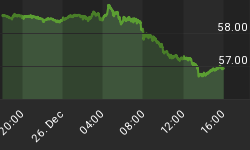A common misconception on Wall Street is that the goal of quantitative easing (QE) is to flood the banking system with additional reserves in the hope it will lower interest rates and spur traditional bank lending. In reality, QE has very little to do with traditional banks, or traditional bank lending. In fact, QE's primary goal is not to lower interest rates. In order to make the best investment and asset allocation decisions possible, investors need to understand the Fed's QE motives and objectives. They also need to understand how QE works in the real world and how the freshly printed money makes its way into a wide range of global asset markets.
QE attempts to flood the global financial markets with fresh cash in an attempt to reinflate asset prices. When the stock market goes up, people and businesses feel more wealthy, and are thus more apt to spend, invest, and take risks (in theory). Rising asset prices can improve the asset side of impaired global balance sheets, which the Fed hopes can rekindle the wealth effect. It is very difficult to get a loan when your personal balance sheet is impaired. If the Fed can boost asset prices, balance sheets become more attractive in terms of the ratio of assets to liabilities. Why do businesses and consumers need to deleverage? The answer is their balance sheets have too much debt and too little equity. Deleveraging was not a hot topic when asset prices were rising.
Our perspective of quantitative easing at CCM is not all that relevant. An individual investor's perspective of QE is not all that relevant. What is important is the Fed's perspective of QE and the perspective of the firms, companies, individuals, and entities who will be receiving large quantities of U.S. dollars created out of thin air by the Fed.
At CCM, we are not fans of money printing. However, the Fed believes money printing is they way to go and they are the ones making the calls that impact asset prices and the purchasing power of the U.S. dollar. You may or may not agree with QE, but it is happening and will most likely continue to happen for years to come. If we are printing money now, what do you think will happen when the Medicare and Social Security situations really get dicey in a few years? The political will is not there and will not suddenly surface to tackle our problems head-on as we should. It is much easier for those in power to print money hoping they can goose the financial markets and economy long enough to get reelected or reappointed one more time. As long as central bankers are running the show, money printing and inflation are here to stay. The problems with debt are going to get worse in the future, not better. Unfortunately, once policymakers start to play with the money supply, it becomes very difficult to stop.
Today's video in our six part series on quantitative easing discusses who gets the Fed's printed money and how that money can find its way into the global financial markets. The flow chart below shows the basic topics covered in the fifth QE video. To best prepare for QE2, QE3, and QE4 (which will all probably come over time), we need to understand the lines of business and clients of the Fed's eighteen primary broker-dealers. PNP Paribas is one of the eighteen dealers; they are based in Europe and their clients include alternative asset managers and pension funds. Their wide array of business interests span from foreign exchange (currencies) to asset protection structures.

Part five of our six part video series on quantitative easing and QE's possible impact on the financial markets outlines the global reach, lines of business, and clients of the Fed's eighteen primary dealers.
Above is part five of the six part series, below are links to parts one through four:
- Video 1: How Does Quantitative Easing Work? QE Explained
- Video 2: Quantitative Easing (QE): The Fed, Finance, and Inflation
- Video 3: Quantitative Easing: History & Objectives of QE
- Video 4: Quantitative Easing: Why is the Fed printing money?
- QE Commentary: Analysis of Bullard's "Seven Faces"
















